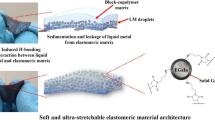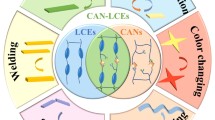Abstract
The low crosslink density characteristic of liquid crystal elastomer (LCE) materials causes poor fatigue resistance performance, which has seriously plagued their prospects in industrial applications. Here we report that the introduction of 5 wt% liquid metal nanodroplets (average diameter: ca. 195 nm) into the LCE network can dramatically reinforce the corresponding composite’s mechanical properties, in particular ultrahigh fatigue resistance, capable of bearing unprecedented 10,000 tensile cycles within a large range of strain amplitude up to 70% and 2000 times of continuous actuating deformations. Furthermore, this liquid metal-incorporated LCE composite material exhibits large actuation stroke (maximum actuation strain: 55%), high actuation stress (blocking stress: 1.13 MPa), fully reversible thermal/photo-actuation functions, and self-healing ability at moderate temperatures, which qualifies the composite material for high-load actuators.
摘要
液晶弹性体材料内在的低交联密度特性导致其抗疲劳性能差, 严重影响了此类材料在工业上的应用前景. 本文报道了一种液态金属增强型液晶弹性体材料, 通过将5 wt%液态金属纳米微粒(平均直径: 约 195 nm)引入液晶弹性体网络, 可以显著增强液晶弹性体复合材料的力学性能, 特别是超高的抗疲劳性能. 该复合材料能够在大应变范围(应变幅度范围高达70%)内承受10,000次拉伸循环和2000次连续可逆致动形变, 同时展现出大致动应变(最大致动应变: 55%)、 大致动应力 (1.13 MPa)、 完全可逆的热/光驱动性和常温下的自修复功能. 该液态金属增强型液晶弹性体材料有望在高载荷致动器领域实现工业化应用.
Similar content being viewed by others
References
Finkelmann H, Kock HJ, Rehage G. Investigations on liquid crystalline polysiloxanes 3. Liquid crystalline elastomers—A new type of liquid crystalline material. Makromol Chem Rapid Commun, 1981, 2: 317–322
Ohm C, Brehmer M, Zentel R. Liquid crystalline elastomers as actuators and sensors. Adv Mater, 2010, 22: 3366–3387
Ube T, Ikeda T. Photomobile polymer materials with crosslinked liquid-crystalline structures: Molecular design, fabrication, and functions. Angew Chem Int Ed, 2014, 53: 10290–10299
White TJ, Broer DJ. Programmable and adaptive mechanics with liquid crystal polymer networks and elastomers. Nat Mater, 2015, 14: 1087–1098
Bisoyi HK, Li Q. Light-driven liquid crystalline materials: From photo-induced phase transitions and property modulations to applications. Chem Rev, 2016, 116: 15089–15166
Kularatne RS, Kim H, Boothby JM, et al. Liquid crystal elastomer actuators: Synthesis, alignment, and applications. J Polym Sci Part B-Polym Phys, 2017, 55: 395–411
Li Q, Schenning APHJ, Bunning TJ. Light-responsive smart soft matter technologies. Adv Opt Mater, 2019, 7: 1901160
Dong L, Zhao Y. Photothermally driven liquid crystal polymer actuators. Mater Chem Front, 2018, 2: 1932–1943
Hu J, Wang W, Yu H. Endowing soft photo-actuators with intelligence. Adv Intelligent Syst, 2019, 1: 1900050
Yang M, Yuan Z, Liu J, et al. Photoresponsive actuators built from carbon-based soft materials. Adv Opt Mater, 2019, 7: 1900069
Jiang ZC, Xiao YY, Zhao Y. Shining light on liquid crystal polymer networks: Preparing, reconfiguring, and driving soft actuators. Adv Opt Mater, 2019, 7: 1900262
Ube T, Ikeda T. Photomobile polymer materials with complex 3D deformation, continuous motions, self-regulation, and enhanced processability. Adv Opt Mater, 2019, 7: 1900380
Mehta K, Peeketi AR, Liu L, et al. Design and applications of light responsive liquid crystal polymer thin films. Appl Phys Rev, 2020, 7: 041306
Ge F, Zhao Y. Microstructured actuation of liquid crystal polymer networks. Adv Funct Mater, 2020, 30: 1901890
Thomsen DL, Keller P, Naciri J, et al. Liquid crystal elastomers with mechanical properties of a muscle. Macromolecules, 2001, 34: 5868–5875
Beyer P, Terentjev EM, Zentel R. Monodomain liquid crystal main chain elastomers by photocrosslinking. Macromol Rapid Commun, 2007, 28: 1485–1490
Wang Z, Li K, He Q, et al. A light-powered ultralight tensegrity robot with high deformability and load capacity. Adv Mater, 2019, 31: 1806849
Yang R, Zhao Y. Multitemperature memory actuation of a liquid crystal polymer network over a broad nematic-isotropic phase transition induced by large strain. ACS Macro Lett, 2018, 7: 353–357
Kim H, Boothby JM, Ramachandran S, et al. Tough, shape-changing materials: Crystallized liquid crystal elastomers. Macromolecules, 2017, 50: 4267–4275
Lu HF, Wang M, Chen XM, et al. Interpenetrating liquid-crystal polyurethane/polyacrylate elastomer with ultrastrong mechanical property. J Am Chem Soc, 2019, 141: 14364–14369
Liu J, Gao Y, Wang H, et al. Shaping and locomotion of soft robots using filament actuators made from liquid crystal elastomer-carbon nanotube composites. Adv Intelligent Syst, 2020, 2: 1900163
Song T, Lei H, Clancy AJ, et al. Supramolecular hydrogen bond enables Kapton nanofibers to reinforce liquid-crystalline polymers for light-fueled flight. Nano Energy, 2021, 87: 106207
Wang J, Huang S, Zhang Y, et al. Hydrogen bond enhances photomechanical swing of liquid-crystalline polymer bilayer films. ACS Appl Mater Interfaces, 2021, 13: 6585–6596
Haque MA, Kurokawa T, Kamita G, et al. Lamellar bilayers as reversible sacrificial bonds to toughen hydrogel: Hysteresis, self-recovery, fatigue resistance, and crack blunting. Macromolecules, 2011, 44: 8916–8924
Lee KY, Rowley JA, Eiselt P, et al. Controlling mechanical and swelling properties of alginate hydrogels independently by cross-linker type and cross-linking density. Macromolecules, 2000, 33: 4291–4294
Ford MJ, Ambulo CP, Kent TA, et al. A multifunctional shape-morphing elastomer with liquid metal inclusions. Proc Natl Acad Sci USA, 2019, 116: 21438–21444
Ford MJ, Palaniswamy M, Ambulo CP, et al. Size of liquid metal particles influences actuation properties of a liquid crystal elastomer composite. Soft Matter, 2020, 16: 5878–5885
Style RW, Wettlaufer JS, Dufresne ER. Surface tension and the mechanics of liquid inclusions in compliant solids. Soft Matter, 2015, 11: 672–679
Kazem N, Hellebrekers T, Majidi C. Soft multifunctional composites and emulsions with liquid metals. Adv Mater, 2017, 29: 1605985
Style RW, Boltyanskiy R, Allen B, et al. Stiffening solids with liquid inclusions. Nat Phys, 2015, 11: 82–87
Yu Q, Zhang Q, Zong J, et al. Identifying surface structural changes in a newly-developed Ga-based alloy with melting temperature below 10 °C. Appl Surf Sci, 2019, 492: 143–149
Koh A, Hwang W, Y. Zavalij P, et al. Solidification and melting phase change behavior of eutectic gallium-indium-tin. Materialia, 2019, 8: 100512
Handschuh-Wang S, Stadler FJ, Zhou X. Critical review on the physical properties of gallium-based liquid metals and selected pathways for their alteration. J Phys Chem C, 2021, 125: 20113–20142
Yakacki CM, Saed M, Nair DP, et al. Tailorable and programmable liquid-crystalline elastomers using a two-stage thiol-acrylate reaction. RSC Adv, 2015, 5: 18997–19001
McCracken JM, Donovan BR, Lynch KM, et al. Molecular engineering of mesogenic constituents within liquid crystalline elastomers to sharpen thermotropic actuation. Adv Funct Mater, 2021, 31: 2100564
Avsar A, Ciarrocchi A, Pizzochero M, et al. Defect induced, layer-modulated magnetism in ultrathin metallic PtSe2. Nat Nanotechnol, 2019, 14: 674–678
Yamaguchi A, Mashima Y, Iyoda T. Reversible size control of liquid-metal nanoparticles under ultrasonication. Angew Chem Int Ed, 2015, 54: 12809–12813
Yarema M, Wörle M, Rossell MD, et al. Monodisperse colloidal gallium nanoparticles: Synthesis, low temperature crystallization, surface plasmon resonance and Li-ion storage. J Am Chem Soc, 2014, 136: 12422–12430
Frohm B, DeNizio JE, Lee DSM, et al. A peptide from human semenogelin I self-assembles into a pH-responsive hydrogel. Soft Matter, 2015, 11: 414–421
Juvé V, Cardinal MF, Lombardi A, et al. Size-dependent surface plasmon resonance broadening in nonspherical nanoparticles: Single gold nanorods. Nano Lett, 2013, 13: 2234–2240
Bartlett MD, Kazem N, Powell-Palm MJ, et al. High thermal conductivity in soft elastomers with elongated liquid metal inclusions. Proc Natl Acad Sci USA, 2017, 114: 2143–2148
Kazem N, Bartlett MD, Majidi C. Extreme toughening of soft materials with liquid metal. Adv Mater, 2018, 30: 1706594
Zhang J, Liu M, Pearce G, et al. Strain stiffening and positive piezoconductive effect of liquid metal/elastomer soft composites. Compos Sci Tech, 2021, 201: 108497
Peng H, Xin Y, Xu J, et al. Ultra-stretchable hydrogels with reactive liquid metals as asymmetric force-sensors. Mater Horiz, 2019, 6: 618–625
Griebel JJ, Glass RS, Char K, et al. Polymerizations with elemental sulfur: A novel route to high sulfur content polymers for sustainability, energy and defense. Prog Polym Sci, 2016, 58: 90–125
Ambulo CP, Ford MJ, Searles K, et al. 4D-printable liquid metal-liquid crystal elastomer composites. ACS Appl Mater Interfaces, 2021, 13: 12805–12813
Lv P, Yang X, Bisoyi HK, et al. Stimulus-driven liquid metal and liquid crystal network actuators for programmable soft robotics. Mater Horiz, 2021, 8: 2475–2484
Pei Z, Yang Y, Chen Q, et al. Mouldable liquid-crystalline elastomer actuators with exchangeable covalent bonds. Nat Mater, 2014, 13: 36–41
Li Y, Zhang Y, Rios O, et al. Liquid crystalline epoxy networks with exchangeable disulfide bonds. Soft Matter, 2017, 13: 5021–5027
Wang Z, Tian H, He Q, et al. Reprogrammable, reprocessible, and self-healable liquid crystal elastomer with exchangeable disulfide bonds. ACS Appl Mater Interfaces, 2017, 9: 33119–33128
Xin Y, Peng H, Xu J, et al. Ultrauniform embedded liquid metal in sulfur polymers for recyclable, conductive, and self-healable materials. Adv Funct Mater, 2019, 29: 1808989
Niu W, Cao X, Wang Y, et al. Photonic vitrimer elastomer with self-healing, high toughness, mechanochromism, and excellent durability based on dynamic covalent bond. Adv Funct Mater, 2021, 31: 2009017
Acknowledgements
This work was supported by the National Natural Science Foundation of China (21971037).
Author information
Authors and Affiliations
Contributions
Yang H designed this project; Lu HF performed all the experiments; Lu HF, Nie ZZ, Bisoyi HK, Wang M, Huang S, Chen XM, Liu ZY and Yang H analyzed the data and wrote the manuscript. All authors contributed to the general discussion.
Corresponding author
Ethics declarations
The authors declare that they have no conflict of interest.
Additional information
Supplementary information Experimental details and supporting data are available in the online version of the paper.
Hai-Feng Lu completed his PhD degree under the supervision of Prof. Hong Yang in 2021. After that, he joined Zhejiang Normal University as a lecturer. His research interest includes functional polymeric materials.
Hong Yang is professor of chemistry and chemical engineering at Southeast University. He earned his BS degree in chemistry from Peking University in 2002, and his PhD degree in chemistry from the University of Colorado at Boulder in 2007 with Prof. David M Walba. After one year industry work as a research scientist of medicinal chemistry in a Chicago pharmaceutical company, he went back to academia and joined Dr. Patrick Keller’s group at Institut Curie in 2008. Since completing his postdoctoral research in the spring of 2010, he has been a faculty at Southeast University. Currently, his research interests are liquid crystal materials and functional polymeric materials.
Rights and permissions
About this article
Cite this article
Lu, HF., Nie, ZZ., Bisoyi, H.K. et al. An ultrahigh fatigue resistant liquid crystal elastomer-based material enabled by liquid metal. Sci. China Mater. 65, 1679–1686 (2022). https://doi.org/10.1007/s40843-021-1966-6
Received:
Accepted:
Published:
Issue Date:
DOI: https://doi.org/10.1007/s40843-021-1966-6




